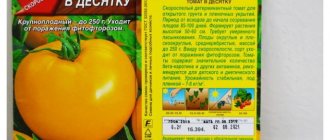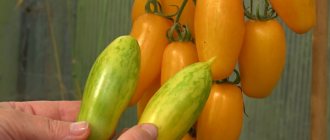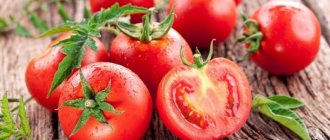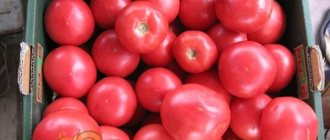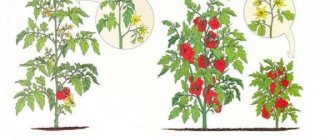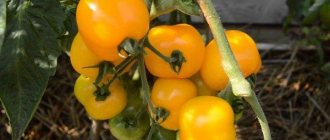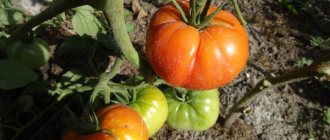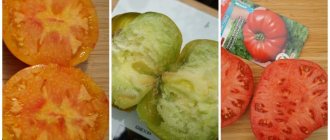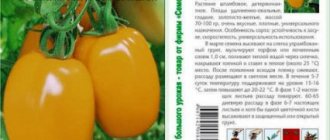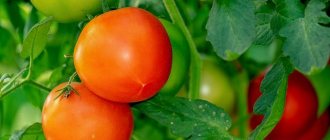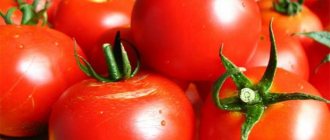Tomato Principe Borghese (Prince Borghese)
Super early variety of Italian selection.
In the middle zone it is recommended for growing in greenhouses and open ground.
The plant is powerful, tall (above 1.8 m), indeterminate type, requires pinching and tying to a trellis. It is recommended to form this tomato into three or four stems. The fruits ripen together in clusters of 7-10 pieces.
The variety is unpretentious in cultivation and is resistant to major tomato diseases. Productivity is high even with temperature changes, fruiting is greatly extended.
The fruits are round-oval in shape with a spout (cherry), small in size (15-20 g), when fully ripe, bright red-orange in color, contain a lot of dry matter and very few seeds. The skin is smooth, dense, the flesh is red, quite dense, aromatic, with a good balanced sweet taste.
The fruits are perfectly transported and stored. Recommended for fresh consumption, making sauces, but especially for drying and drying.
Growing seedlings
Sowing of tomato seeds of the Prince Borghese variety is carried out 60-65 days before the planned planting in the ground.
- Seeds are placed in a container with prepared soil or substrate, planting them to a depth of 1 cm. It is recommended to first soak them in an aqueous solution of potassium permanganate or a product that stimulates growth;
- The ground is sprayed from above with warm water from a spray bottle and covered with glass or film. Waiting for the first shoots to appear. For seeds to germinate, a fairly high temperature is required, approximately +30 degrees;
- after the beginning of the stage of formation of two true leaves, picking is performed. Peat pots are used for this. The importance of picking is that it stimulates the development of the crop and increases the resistance of the future plant to external influences; factors;
- Watering is carried out as the soil surface dries.
For reference. Seedlings should be kept in a bright place. Extend daylight hours to 14 hours. Plants can be planted in the ground when the first flower stalk forms.
Tomato San Marzano (San Marzano)
Mid-season variety of Italian selection.
In the middle zone it is recommended for cultivation in greenhouses; in the southern regions it can be cultivated in open ground.
The plant is tall (above 1.8 m), indeterminate type, requires pinching and tying to a trellis. It is recommended to form this tomato into two or three stems. The fruits ripen in clusters.
The variety is demanding in care, heat-loving, resistant to major tomato diseases, but can rot if over-watered. Productivity is high, fruiting is extended.
The fruits are slightly irregular, elongated in shape (cream), medium in size (90-120 g), dark red in color when fully ripe, contain a lot of dry matter and very few seeds. The skin is smooth, dense, resistant to cracking, the flesh is red, dense, fleshy, but dry, with an average sweet and sour taste.
The fruits are perfectly transported and stored. Recommended for fresh consumption, canning, but especially for sauces, drying and drying.
San Marzano tomatoes, along with Del Vesuvio tomatoes, are recognized as the only tomatoes in the world that can be used for Vera Pizza Napoletana (real Neapolitan pizza).
Farmer reviews
Most gardeners who have grown Prince Borghese tomatoes note high yields: according to them, the bushes are literally showered with fruits. The taste of ripe tomatoes is sweet and balanced. The crop requires good care, but certainly rewards the farmer with a generous harvest.
Housewives note that canned tomatoes have an amazing taste. Some prepare an Italian delicacy from them - sun-dried tomatoes, and also emphasize the high taste qualities of this vegetable.
Watch a video on how to grow good tomatoes:
Noticed a mistake? Select it and press Ctrl+Enter to let us know.
The high-yielding tomato Prince Borghese is distinguished by the shape of small fruits that strew the bush. Tomatoes are used to prepare salads and decorate dishes.
Tomato De Barao yellow (golden)
Medium late variety of Brazilian selection.
In the middle zone it is recommended for growing in greenhouses and open ground.
The plant is tall (above 2 m), strong, indeterminate type, weakly leafy, requires pinching and tying to a trellis. It is recommended to form this tomato into one or two stems. The fruits ripen in clusters.
The variety is cold-resistant, heat-loving, shade-tolerant, and resistant to major tomato diseases (especially late blight). Productivity is average, fruiting is extended.
The fruits are smooth, round-oval in shape (cream), medium in size (70-100 g), bright yellow in color when fully ripe. The skin is smooth, dense, resistant to cracking, the flesh is yellow, dense, fleshy, with a bright sweet and sour taste.
The fruits are well transported, stored and ripened. The purpose is universal.
Review Reviews
Reviews from gardeners confirm his description regarding the fertility of the plant, the taste of tomatoes and methods of its use and storage. The fruits ripen quite slowly, however, when collected, they are well stored and reach the desired state. Tomatoes on the bush are located in a group and often, but as the height of the plant increases, the size of the fruit decreases.
One user of the tomato variety reports the following. Despite the low temperatures atypical for summer, a huge number of tomatoes were produced in 2021. The harvest is uniform in size, the tomatoes are sweet and tasty. The bourgeois prince does not demand royal conditions at all; he regulates his own growth. The tomato was grown in greenhouse conditions in the Moscow region and greatly pleased its owners.
Tomato Black Moor
Mid-season variety of Russian selection.
In the middle zone it is recommended for growing in greenhouses and open ground.
The plant is of medium size (1-1.3 m), semi-determinate type, requires pinching and tying to a trellis. It is recommended to form this tomato into three or four stems. The fruits ripen in clusters of 8-18 pieces.
The variety is undemanding in care, resistant to weather vagaries and major tomato diseases, but susceptible to blossom end rot during drought. Productivity is good, fruiting is extended.
The fruits are round-oval in shape (cream), small and medium in size (30-80 g), when fully ripe, red-brown in color with dark “shoulders”, contain a lot of dry matter. The skin is smooth, dense, moderately resistant to cracking, the flesh is red, dense, fleshy, and has a very sweet taste.
The fruits are well transported, stored and ripened. The purpose is universal.
Recommendations for cultivation and care
The first thing you need to pay attention to when planting Prince Borghese tomato bushes is the area. No more than three bushes should be placed per 1 m2
The distance between each plant is 50 cm. Beds for tomato bushes of this variety should be laid out in a bright place, well lit by the sun and protected from drafts.
It is important that last season the area chosen for Prince Borghese bushes was not planted with related tomato crops: potatoes, eggplants, peppers, and other varieties of tomatoes. It would be nice if onions, cabbage, carrots, radishes, and turnips grew in this place
Basic rules for caring for Prince Borghese tomato bushes:
- watering should be moderate and carried out 2-3 times a week;
- pinching is carried out every 10-12 days%
- Fertilizers are applied 1-2 times a month.
In the northern regions, as well as the middle zone, it is better to grow this variety in greenhouse conditions so that the ambient temperature does not fall below +16 degrees.
The seedlings need to be hardened off 1-2 weeks before planting in the ground. To do this, the boxes with it need to be placed outside. The day before planting in the ground, stop watering.
Proper planting of Prince Borghese bushes:
- first loosen the soil for good air permeability and water flow;
- make 10 cm indentations in the ground;
- transplant the sprouts here by transshipment, together with a lump of earth, otherwise the roots will be damaged;
- water the hole and cover it with soil.
Since Prince Borghese is a tall variety, the bushes require vertical support. The whip is tied to it as it grows.
Tomatoes should be fed once a week. The best option for them is complex mineral compositions with potassium, phosphorus, iron, cobalt, and selenium. There are such suitable types of fertilizers on sale as Kemira, Effecton.
It is recommended to mulch the ground under the bushes. Straw, sawdust, and manure are suitable for this. This procedure will prevent overheating of the soil, as well as contact of fruits with the soil and associated rotting and infection with fungal diseases. This variety of tomatoes requires regular loosening and weeding.
Experienced gardeners have a secret that allows them to eliminate diseases of Prince Borghese tomatoes. To avoid problems, you need to grow them in metal buckets dug into the ground or simply placed in a garden bed or greenhouse. Thanks to this, pests will not damage the crop.
Features of cultivation, possible difficulties
As the bushes of the Prince Borghese variety grow, it is necessary to carry out the pinching procedure. We are talking about removing adventitious shoots that form between the trunk and leaves of the plant.
As for the height of the supports to which growing bushes are tied, their height should be at least 2 m. Any long sticks can be used as them.
Diseases and pests
Tomato bushes of the Prince Borghese variety can be threatened by such common diseases as:
- brown spot. Brown spots covered with a gray coating appear on the leaves;
- mosaic of tomatoes. In this case, the color of the leaves changes, yellow or dark green spots form on them, the surface wrinkles, the fruits dry out and turn yellow;
- late blight The first sign of the disease is brown spots that appear under the skin of tomatoes.
Pests of fruits of the Prince Borghese variety:
- Colorado beetle;
- mole cricket;
- slugs;
- wireworms.
Pests are controlled using special preparations. Fungal diseases are eliminated using fungicides. Some plant diseases occur due to improper care.
Tomato Rio Grande
Mid-late variety of Dutch selection.
In the middle zone it is recommended for cultivation in greenhouses; in the southern regions it can be cultivated in open ground. Can be grown without seedlings.
The plant is of medium size (0.7-1 m), determinate type, powerful, compact, but requires moderate pinching and tying to a trellis. The fruits ripen together in clusters of 8-10 pieces.
The variety is undemanding in care, heat-resistant, resistant to major tomato diseases and difficult climatic conditions. Productivity is high, fruiting is extended.
The fruits are smooth, elongated in shape (cream), medium in size (100-120 g), dark red in color when fully ripe, contain a lot of dry matter and very few seeds. The skin is smooth, dense, thick, resistant to cracking, the flesh is red, very dense, fleshy, dry, with a good sweet and sour taste.
The fruits are well transported, stored and ripened. The purpose is universal.
Growing in a greenhouse
The features of growing Prince Borghese tomatoes in open ground conditions were described above.
They can also be grown in a greenhouse. Here they are planted in the soil also after the seed germination process. An important condition is the location of the greenhouse in a well-lit place, since tomatoes of the described variety love solar heat and light.
The humidity in the greenhouse should not be too high, otherwise the taste and quality of the fruit will be poor. In this case, after planting the bushes in the soil, experienced gardeners recommend refraining from active watering. Under such conditions, the roots, trying to reach moisture, will stretch deeper. Thanks to this, a powerful root system develops.
Note! To get a good harvest, you must form a plant. To do this, you need to remove all the stepsons, that is, form the crop into one stem. You need to remove shoots throughout the growing season of the tall Prince Borghese variety of tomatoes.
In order for the flowers to be pollinated, they need to be shaken periodically. It is better to do this on a sunny, warm day. Tomatoes grow quite quickly in a greenhouse: no more than three months pass from planting the seeds to the appearance of the first fruits.
To prevent late blight, it is recommended to spray the bushes with whey, infusion of tobacco dust or garlic. The soil in the greenhouse needs to be changed annually.
Advantages and disadvantages of the Brazilian giant variety
The most important “advantage” of this variety is its large fruits, which is why summer residents grow it. It is excellent for cultivation in closed ground conditions, as it evenly fills the entire space of the greenhouse.
The advantages of the variety also include the following properties:
- optimal timing of fruit ripening (in a state of technical ripeness, tomatoes can be picked from the Giant after 115 days);
- excellent taste of the fruit;
- the ability to grow the variety even in regions of risky farming (but only in greenhouses);
- resistance to diseases.
The seeds of this tomato are purchased from collectors; they are not available for sale in stores. And since this is a variety, not a hybrid, if you wish, you can always get your own seeds and grow a tomato from them.
Thanks to the juiciness of the fruit, the Brazilian giant is excellent for a wide variety of culinary preparations. These tomatoes make excellent sauces, ketchups, juices, and dressings.
"Disadvantages" of the variety:
- the need for mandatory bush formation;
- stepsoning;
- carrying out enhanced fertilizing;
- the fruits of this tomato may turn out slightly clumsy (if some agrotechnical practices have been violated);
- Tomatoes may crack if not watered regularly.
Plant shaping is a technique that is used for most indeterminate varieties and hybrids, and gardeners need to take this into account. You can get the yields and large tomatoes stated in the descriptions only if you have some experience in growing the crop, if you have the time to carry out pinching and systematic watering, and not leave the tomato to the mercy of fate.
Pay attention to your tomatoes, provide them with proper care, and your Brazilian giant will truly be a giant.
Features of growing Brazilian giant tomato
Indeterminate tomatoes require special care, but this is compensated by excellent results. Unlike low varieties, indets have higher yields; in addition, they have an extended fruiting period.
Growing seedlings
The age of seedlings when planted in shelters should be about 60 days. Based on these dates, the time for sowing seeds for seedlings is calculated, and usually this is the beginning of March.
Seeds require preliminary preparation:
- disinfection (use garlic infusion, potassium permanganate);
- soaking in special growth stimulants (you can use aloe juice diluted in water for this, as well as ready-made compositions Epin, Energen, Zircon);
- germination.
Sow in prepared soil mixture - in common boxes, containers, individual cups. It is advisable to first use small containers for more uniform growth and proper formation of the root system of plants, and then carry out picking (from common boxes into separate glasses), or transshipment.
Twice during the period of growing seedlings, it needs to be fed.
ON A NOTE! Fertilizing begins only after picking, after waiting approximately 10-12 days.
For seedlings, it is better to use complex fertilizers, ready-made formulations for nightshades. The Brazilian giant is planted in a greenhouse only when stable warm weather has established, and the soil temperature must be at least +16ºC (depth 10 cm)
Tomato care
Three seedlings are planted per square meter, this will provide space for the tomatoes. Equip the greenhouse in advance with supports for trellises or install garter stakes for each plant. You need to tie up not only the stem, but also individual tomato brushes so that they do not break under the weight of the tomatoes.
When planting, it is advisable to add fertilizer to the holes to provide the tomatoes with adequate nutrition for the first time.
ON A NOTE! The plants are not watered for the first 6-7 days, giving time for the formation of the root system.
In the future, watering is carried out regularly, taking into account weather conditions and the condition of the plants themselves. Tomatoes do not need frequent watering, optimally - twice a week (taking into account the weather). If it’s hot, water more often, but make sure that the soil under the tomatoes is well moistened and the humidity levels in the greenhouse are not exceeded.
You can’t water tomato bushes, this leads to diseases and a decrease in yield. When growing large-fruited varieties, watering is of particular importance, and in this case, the best option would be to equip a drip irrigation system. Water will flow evenly to the roots of the plants, drought and excessive moisture are eliminated, and the fruits will not crack. Such systems are also very convenient if summer residents are on the site only on weekends, and it is not possible to adjust watering.
Indets usually form the first flower cluster after 8-9 leaves, and after 115-120 days the first fruits can be harvested. It is necessary to take into account that the clusters of such tomatoes need to be formed, and in order to obtain tomatoes of large mass, no more than two fruits are left in the cluster.
Bush formation
The best option for growing the Brazilian giant is to grow the plant in one trunk, removing all side branches and stepsons. Why is this being done?
- Stepchildren take on a large amount of nutrients, which leads to a decrease in the number of flower clusters and a decrease in yield.
- A large number of leaves are formed on the side branches, which not only “take away” food, but also create a dense crown of the bush. This interferes with air circulation, the humidity in the greenhouse increases, and the tomatoes begin to hurt.
If you want to get a large tomato, leave one or two flowers in the brush. The lower leaves of the plant are also removed, but not immediately, but gradually. By the time the fruits are formed on the first flower cluster, there should be no leaves in the lower part of the bush.
For support, trellises, a special agricultural mesh or ordinary stakes with fabric ribbons are used. It is not recommended to use twine for gartering, as it causes wounds on the branches and trunk of the tomato (the rope cuts into the plant tissue).
Feeding large-fruited tomatoes
Experienced gardeners know that such varieties require not only proper formation, but also enhanced nutrition. Without fertilizing, which must be done at least 3-4 times during the season, you will not get large tomatoes, since the plant simply does not have enough strength to form giant fruits.
The following are used as fertilizers:
- mullein, bird droppings (be sure to dilute in water, observing the proportions, otherwise you can get a burn to the root system of tomatoes);
- complex fertilizers (nitrophoska);
- various ready-made formulations that are intended for feeding tomatoes during different periods of the growing season (KEMIRA, IDEAL, AGRICOLA);
- infusions of ash;
- baker's yeast (diluted in water, used no more than twice a summer);
- green infusions of herbs (nettle, comfrey, dandelion);
- mineral fertilizers.
The first feeding is carried out no earlier than 15-18 days after planting the tomatoes. Subsequent ones - after 10-12 days, but the condition of the plants themselves must be taken into account. At the beginning of the growing season, tomatoes need nitrogen; during flowering and fruit formation, the share of nitrogen is reduced, and the portion of potassium and phosphorus is increased.
You should not apply too large doses of nitrogen fertilizers, as this will “fatten” the plants and cause a powerful growth of the vegetative above-ground mass to the detriment of the fruits.
The Brazilian giant is mainly resistant to various diseases. But for prevention, it would not be superfluous to treat plants with copper-containing preparations, Bordeaux mixture. Typically, gardeners use natural ingredients in preventive measures - herbal infusions, garlic, which are both effective and non-toxic.
To obtain large fruits, it is recommended to leave several clusters on the stem (for example, 3-5), and remove the rest. In August, the main stem is pinched, thereby giving the plant the opportunity to “throw” all its strength and nutrition into the existing flower clusters.
Cleaning
The fruits are usually harvested at a state of technical ripeness so that they ripen at home. But it all depends on the gardener himself, since some prefer to ripen the tomatoes, while others want the fruits to ripen right on the bushes. If the weather permits, you can do this, but if it gets cool, it is better to collect the tomatoes and put them in boxes or boxes for ripening.
The Brazilian giant variety, despite the fact that it was bred far from Russia, has successfully adapted to new conditions and, when taken care of, will certainly delight you with a good harvest.
